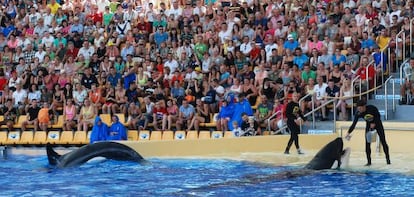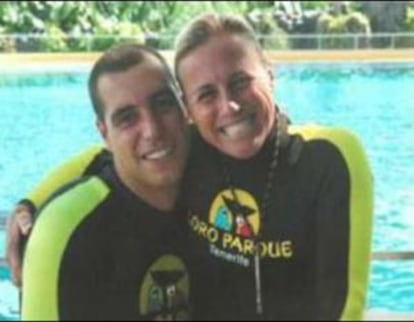Killers, but only in captivity
The deaths of orca trainers in the US and Spain two months apart are examined in a new documentary


In an investigation into a violent death, every little detail can be important in order to trace the line between cause and consequence. In the case of two such deaths, both related but separated by an ocean, that line can become a polyhedron and, on occasion, a film. Blackfish, due for release on October 31, is such a film, and details an event in the United States linked to another in Spain that passed by almost unnoticed.
On December 24, 2009 Alexis Martínez was "attacked," according to a forensic report, by a 5,000-kilogram killer whale called Keto during a training session at Tenerife's Loro Parque, which has six of the 48 orcas that are currently held in captivity worldwide. The 29-year-old Martínez was killed almost instantly, but the scheduled show took place in the same pool an hour later. Just two months after the incident, the same thing happened to a trainer called Dawn Brancheau, when Tillikum, a 40-year-old male orca captured off the coast of Iceland and implicated in three deaths while in captivity, fatally attacked her in a pool in Orlando.
Both "accidents" occurred under the auspices of the same company, Sea World, which considers itself the leading authority on the treatment of the animals in captivity. The firm has attractions in San Antonio, Orlando and San Diego, and had loaned some of its orcas to Loro Parque.
Hugely intelligent, orcas are described by some experts as possessing something approaching culture. Capturing wild orcas has been prohibited by international law since the 1990s.
In the United States, Brancheau's death caused a huge media storm - CNN commentator Larry King dedicated a show to the incident, and it sparked debate in the House of Representatives. But in Spain Martínez's death was the subject of a "scandalous media blackout," in the words of an opposition councilor in the Puerto de la Cruz city authority. Unknown entirely on the mainland, it was hardly even covered in the local press, of which Loro Parque is a major source of advertising revenue.

The legal process in the United States - which ordered Sea World's trainers out of the water and fined the company the maximum $75,000 for a crime of "violation of employee safety" - is ongoing. In Spain, despite the protestations of Mercedes Hernández, Martínez's mother, the case was shelved in April 2012 for a lack of criminal evidence, according to a ruling by the Santa Cruz de Tenerife High Court. However, a report by the works inspectorate stated that Martínez was a sound technician who, since 2006, "had carried out the functions of a senior trainer in the orca show, although he was contracted as an assistant."
Martínez did not have any qualifications to train animals, "nor had he received specialist training in Sea World's parks in the United States."
Two years before Martínez was attacked another serious incident had occurred at Loro Parque, when trainer Claudia Vollhardt was butted by an orca and dragged underwater.
"[Martínez] started playing the music for the show and ended up with the orcas because he liked them. People said he had a knack," says Hernández, a 54-year-old teacher who received 130,000 euros in compensation for the loss of her son through an insurance policy.
With the release of Blackfish, the questions over the ethics of holding orcas in captivity are being put on the table. Is it conservation or is it business? With 1.3 million visitors a year at 33 euros a ticket, Loro Parque rakes in some 40 million a year and competes with the Teide National Park, a UNESCO World Heritage Site, as Tenerife's most popular tourist attraction. The park's orcas dominate the island - on billboards at the airport and at every set of traffic lights, on trash cans and even bottled water. Sea World had a turnover of 56.5 million euros in 2012, according to Forbes .
Martínez's death was the subject of a "scandalous media blackout" in his native Spain
"What we are talking about is a business operating under the guise of investigation and conservation," says Vidal Martín, president of the Society for the Study of Cetaceans in the Canary Islands. "You cannot promote the raising of these animals in captivity because no matter how big their space is, it will always be too small. This generates stress, and is why they attack. There are no instances of aggression [toward humans] by wild orcas, and there is no scientific program that justifies their captivity." The park defends its activity as "a vehicle for social awareness," and says it spends 500,000 euros a year on each orca. But it recently came under fire for acquiring Morgan, a lone female orca calf that became disoriented and was captured off the coast of the Netherlands under a rehabilitation-and-release permit. She was to be returned to the wild but a court ruled that she be taken to Loro Parque instead, a decision that is being appealed in the Dutch courts by scientists, who say she is perfectly equipped to be reintroduced.
Dr Ingrid Visser, an orca expert, reported that Morgan is suffering terribly in captivity, chewing on the concrete of her tank and repeatedly banging her head against a metal gate, behavior that has never been recorded before. Sea World responded to inquiries with its "questions protocol." "Visitors leave with a greater understanding of conservation."
Tu suscripción se está usando en otro dispositivo
¿Quieres añadir otro usuario a tu suscripción?
Si continúas leyendo en este dispositivo, no se podrá leer en el otro.
FlechaTu suscripción se está usando en otro dispositivo y solo puedes acceder a EL PAÍS desde un dispositivo a la vez.
Si quieres compartir tu cuenta, cambia tu suscripción a la modalidad Premium, así podrás añadir otro usuario. Cada uno accederá con su propia cuenta de email, lo que os permitirá personalizar vuestra experiencia en EL PAÍS.
¿Tienes una suscripción de empresa? Accede aquí para contratar más cuentas.
En el caso de no saber quién está usando tu cuenta, te recomendamos cambiar tu contraseña aquí.
Si decides continuar compartiendo tu cuenta, este mensaje se mostrará en tu dispositivo y en el de la otra persona que está usando tu cuenta de forma indefinida, afectando a tu experiencia de lectura. Puedes consultar aquí los términos y condiciones de la suscripción digital.
Últimas noticias
From digital curfews to blocking apps: How technology experts protect their children online
Why the price of coffee has skyrocketed: from Brazilian plantations to specialty coffee houses
Confined to a Cuban hospital: When electricity is a matter of life or death
The complicated life of Francesca Albanese: A rising figure in Italy but barred from every bank by Trump’s sanctions
Most viewed
- Why we lost the habit of sleeping in two segments and how that changed our sense of time
- Pablo Escobar’s hippos: A serious environmental problem, 40 years on
- Trump’s obsession with putting his name on everything is unprecedented in the United States
- The Florida Keys tourist paradise is besieged by immigration agents: ‘We’ve never seen anything like this’
- Charles Dubouloz, mountaineering star, retires at 36 with a farewell tour inspired by Walter Bonatti








































